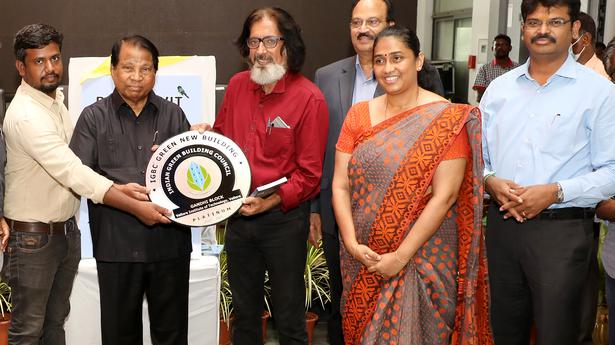
VIT’s Gandhi building in Vellore gets green award
The Hindu
It was presented by Indian Green Building Council
The Gandhi building block in Vellore Institute of Technology (VIT) here has received platinum rating from the Indian Green Building Council (IGBC), a Hyderabad-based council that is part of the Confederation of Indian Industry (CII).
According to a press release, VIT was the first higher education institute in the State to get the platinum rating for the building. The IGBC green ratings are aimed at enabling projects to fulfil United Nations’ Sustainable Development Goals (SDG).
The platinum shield was presented to G. Viswanathan, chancellor, Vellore Institute of Technology (VIT), by Krithika Muthukrishnan on behalf of IGBC in the presence of VIT vice-president G. V. Selvam, president of Indian Institute of Architects, C.R. Raju and architect Sanjay Mohe .
“I hope this initiative by VIT will help the country’s efforts in building a more sustainable nation as envisioned by sustainable development goals and COP26. Many Indian higher education institutions with large campuses and unique geographic locations may become conservatories of local biodiversity by little effort,” Mr. Vishwanathan said.
“Dotted with various native tree species with large lawns, the Gandhi building on VIT’s Vellore campus has vast open spaces, adequate ventilation, natural lighting, perforated facade, courtyards, atriums, and corridors. The building has a radiant cooling with an indirect evaporative cooling system that satisfies the cooling needs of the studio-type classrooms, corridors, seminar halls and laboratories in the building. The building was envisioned by VIT and designed by Mindspace Architects. Green building rating was facilitated by Green Sketch Consultants,” the release added.

“Writing, in general, is a very solitary process,” says Yauvanika Chopra, Associate Director at The New India Foundation (NIF), which, earlier this year, announced the 12th edition of its NIF Book Fellowships for research and scholarship about Indian history after Independence. While authors, in general, are built for it, it can still get very lonely, says Chopra, pointing out that the fellowship’s community support is as valuable as the monetary benefits it offers. “There is a solid community of NIF fellows, trustees, language experts, jury members, all of whom are incredibly competent,” she says. “They really help make authors feel supported from manuscript to publication, so you never feel like you’re struggling through isolation.”

Several principals of government and private schools in Delhi on Tuesday said the Directorate of Education (DoE) circular from a day earlier, directing schools to conduct classes in ‘hybrid’ mode, had caused confusion regarding day-to-day operations as they did not know how many students would return to school from Wednesday and how would teachers instruct in two modes — online and in person — at once. The DoE circular on Monday had also stated that the option to “exercise online mode of education, wherever available, shall vest with the students and their guardians”. Several schoolteachers also expressed confusion regarding the DoE order. A government schoolteacher said he was unsure of how to cope with the resumption of physical classes, given that the order directing government offices to ensure that 50% of the employees work from home is still in place. On Monday, the Commission for Air Quality Management in the National Capital Region and Adjoining Areas (CAQM) had, on the orders of the Supreme Court, directed schools in Delhi-NCR to shift classes to the hybrid mode, following which the DoE had issued the circular. The court had urged the Centre’s pollution watchdog to consider restarting physical classes due to many students missing out on the mid-day meals and lacking the necessary means to attend classes online. The CAQM had, on November 20, asked schools in Delhi-NCR to shift to the online mode of teaching.









